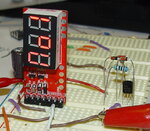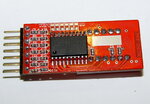gppk
Newbie level 4
Hey,
So I bought myself a box of mints today and they come in a tiny little box 70mmX 25 x 15.
I wanted to see if it was possible to build a tiny ohmmeter circuit inside with these basic functionality:
So by doing some research on ze googles i've worked out that this isn't going to be easy.
really I wanted to know how you guys would go about it. If you have used any screens that are small and easy to use.
Any help really would be great
Thanks.
G./
So I bought myself a box of mints today and they come in a tiny little box 70mmX 25 x 15.
I wanted to see if it was possible to build a tiny ohmmeter circuit inside with these basic functionality:
- Small Screen for Resistance
- Switch for on/off
- Connector for external 9v battery
- Two connector pads to connect resistor that needs measuring
So by doing some research on ze googles i've worked out that this isn't going to be easy.
really I wanted to know how you guys would go about it. If you have used any screens that are small and easy to use.
Any help really would be great
Thanks.
G./







